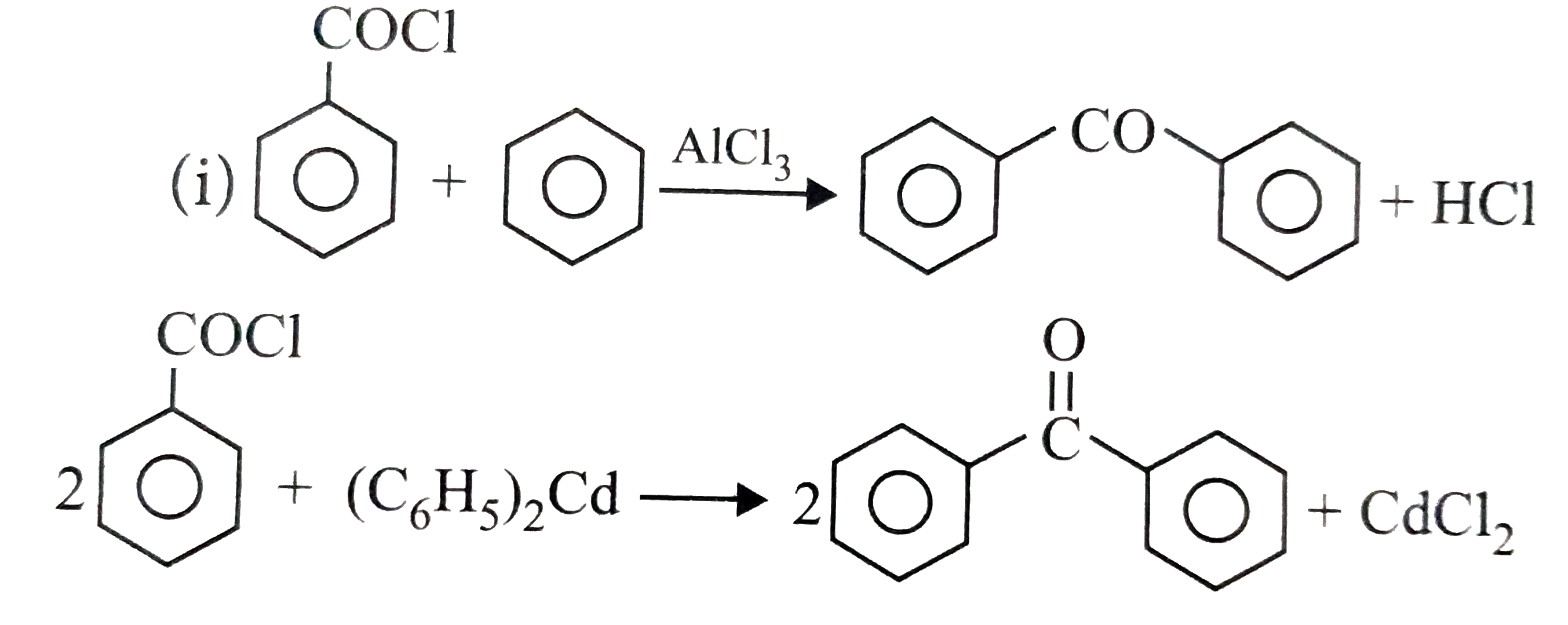Benzophenone can be obtained by
I. Benzoyl chloride +Benzene+AlCl3
II. Benzoyl chloride + Diphenyl cadmium ltbr> III. Benzoyl chloride+Phenyl magnesium chloride ltbr> IV. Benzene+ Carbon monoxide+ ZnCl2
Select an appropirate option
(i) and (ii)
(ii) and (iii)
(i) and (iii)
(i), (ii) and (iii)
The correct Answer is:C
Related Playlists
- BOOK - NCERT FINGERTPS ENGLISHCHAPTER - ALDEHYDES, KETONES AND CARBOXYLIC ACIDSEXERCISE - MCQs(PHYSICAL PROPERTIES )2videos
ALDEHYDES, KETONES AND CARBOXYLIC ACIDS
- BOOK - NCERT FINGERTPS ENGLISHCHAPTER - ALDEHYDES, KETONES AND CARBOXYLIC ACIDSEXERCISE - MCQs( CHEMICAL REACTIONS )50videos
ALDEHYDES, KETONES AND CARBOXYLIC ACIDS
- BOOK - NCERT FINGERTPS ENGLISHCHAPTER - ALDEHYDES, KETONES AND CARBOXYLIC ACIDSEXERCISE - Assertion And Reason15videos
ALDEHYDES, KETONES AND CARBOXYLIC ACIDS
- BOOK - NCERT FINGERTPS ENGLISHCHAPTER - ALCOHOLS,PHENOLS AND ETHERSEXERCISE - Assertion And Reason14videos
ALCOHOLS,PHENOLS AND ETHERS
- BOOK - NCERT FINGERTPS ENGLISHCHAPTER - AMINES EXERCISE - ASSERTION & REASON CORNER14videos
AMINES
Similar Questions
State how the following conversions can be carried out:
(i) Ethyl chloride to Ethyl alcohol.
(ii) Ethyl chloride to Ethene.
(iii) Ethene to Ethyl alcohol.
(iv) Ethyl alcohol to Ethene.View SolutionHow are the following conversions carried out ?
i. Propene → Propan-2-ol
ii. Benzyl chloride → Benzyl alcohol
iii. Ethyl magnesium chloride → Propan-1-ol
iv. Methyl magnesium bromide → 2-Methylpropan-2-olView SolutionHow are the following conversions carried out ?
i. Propene → Propan-2-ol
ii. Benzyl chloride → Benzyl alcohol
iii. Ethyl magnesium chloride → Propan-1-ol
iv. Methyl magnesium bromide → 2-Methylpropan-2-olView SolutionHow are the following conversions carried out ?
i. Propene → Propan-2-ol
ii. Benzyl chloride → Benzyl alcohol
iii. Ethyl magnesium chloride → Propan-1-ol
iv. Methyl magnesium bromide → 2-Methylpropan-2-olView Solution(a) Give the equations of the following reactions:
(i) Oxidation of propan-1-ol with alkaline KMnO4 solution.
(ii) Propene to propan-2-ol
(iii) Benzyl chloride to benzyl alcohol
(iv) Ethylmagnesium chloride to propan-1-ol.
(b) Write the reactions and their conditions only for the commercial preparation of phenol from cumene.View SolutionName the electrophile produced in the reaction of benzene with benzoyl chloride in the presence of anhydrous AlCl3. Name the reaction also.
View SolutionGive reasons for the following :
(i) Metals can be recovered from their ores by chemical methods.
(ii) High purity metals can be obtained by zone refining method.
(iii) Why is sodium choride added during electrolysis of fused anhydrous magnesium chloride ?
(iv) Why is chalcocite roasted and not calcinated during recovery of copper ?View SolutionWrite down the formulae of
(i) sodium oxide
(ii) aluminium chloride
(iii) sodium sulphide
(iv) magnesium hydroxideView SolutionGive chemical equations and name the main product formed when
(i) Ethyl alcohol is mixed with air and passed over Ag catalyst at 520 K.
(ii) Benzoyl chloride is treated with lithium tri-tert-butoxy aluminium hydride.
(iii) Isoprophlidene chloride is treated with caustic potash.
(iv) Methylmagnesium iodide is treated with HCN and the resultant product is hydrolysed.View SolutionConsider the following statement acetophenone can be prepared by
(1) Oxidation of 1-phenylethanol
(2) Reaction of banzylalcohol with methyl magnesium bromide
(3) Friedel-Crafts reaction of benzene with acetyl chloride
(4) Distillation of calcium benzoateView Solution



